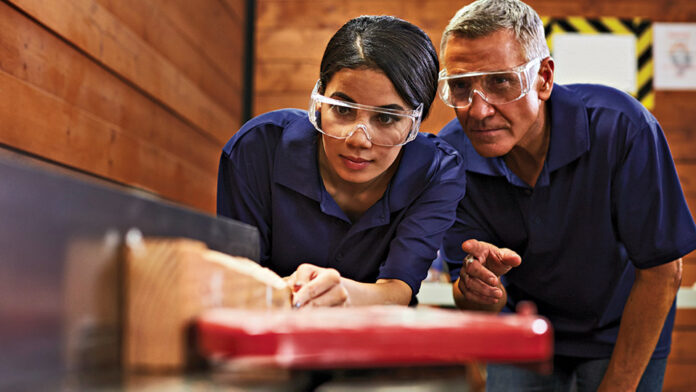By Leah Nord, Senior Director, Operations, CHBA
We have a skilled labour shortage in Canada. The federal government has stated that we need to build 5.8 million homes over the next decade to address housing affordability and chronic lack of supply, which is double the housing starts annually we’d normally have. Yet, according to BuildForce Canada, 20 per cent of workers are going to retire within 10 years, and nearly 40 per cent will be over the age of 55. We need more than 100,000 workers to replenish the retirees to maintain the status quo, but we don’t have the projected domestic workforce capacity to do so, let alone to double housing starts, or to meet the increasing demand for renovations and retrofits.
Additionally, with government’s ambitious immigration targets and the upsurge of temporary residents, there will be even further pressures on the Canadian housing market. In response, there has been some push back in some circles to Canada’s immigration numbers. This pushback is misplaced: Immigration isn’t the issue, housing supply is. And to increase housing supply, Canada is going to need new Canadians to help us build those homes.
Promoting careers in skilled trades
CHBA’s first pillar to address labour shortages in the residential construction industry is to attract and retain more Canadians. Collectively, we need to promote skilled trades and the residential construction sector to Canadians – including non-traditional talent pipelines (youth, women, minorities, second career and veterans) – as an enviable employment option. We also need to focus on retention and promotion within the industry, and to invest in training and upskilling to support individuals through their careers.

Immigration
Secondly, we need to increase immigration specifically for residential construction. Historically, Canada’s tradition has been to accept immigrants with higher education and professional degrees, rather than skilled trades.
In 2022, the Government of Canada introduced a six category TEER system (Training, Education, Experience and Responsibilities) for all occupations in Canada.
The current immigration system for economic immigrants (roughly 60 per cent of immigrants coming into Canada) leans heavily into TEER 0, 1 and 2, sometimes dipping into TEER 3.
In May 2023, the government of Canada introduced an innovative initiative into the immigration selection process for economic immigrations (known as Express Entry):
For the first time, there will be a category-based selection process for priority jobs in high-demand sectors, including the building trades.
The federal government identified 10 priority construction industry occupations. Plumbers, machine fitters, millwrights and welders fall into TEER 2 and residential/commercial installers and servicers are TEER 3 occupations. The latter includes eavestrough installers, exterior cladders, irrigation technicians and window installers.
This new initiative is definitely a step forward, and CHBA has welcomed this shift. However, further focus needs to be placed on the residential construction sector specifically. CHBA is advising government that in addition to those already on the government list (carpenters, electricians), priority professions include framers, installers, plasterers and finishers. And one of the most in-demand needs are for general labourers and trades helpers, which are in TEER 5.
Residential construction offers a pathway to successful careers for immigrants, but we need to target the right entrants with the right competencies, transferrable experience and desire to build a career in the sector. Applicants don’t need extensive qualifications in these lower TEERs, but they do need affinity to this kind of work and language proficiency, and from there can grow into valuable skilled workers for the sector.
But a new approach brings several new questions. How do we assess competency in non-credentialled professions for entry to Canada? How can we have confidence that these new Canadians are qualified, with language proficiency for health and safety? How do we job match and best facilitate labour market integration? CHBA is engaged with the government with recommendations to answer all of these questions, and as a willing partner to help ensure this can happen successfully.

Temporary foreign workers
CHBA also knows that the Temporary Foreign Worker Program (TFWP) needs to be modernized to allow greater use by the residential construction sector. Outside of our members involved in factory-built systems, few of our members who build onsite use the program. Small companies, which are common in our industry, don’t have the awareness or capacity to navigate the lengthy, costly, cumbersome TFWP process. The federal government will need to improve the timelines and approval processes, better adjust permit requirements to respond to the cyclical nature of our industry, consider pathways to permanent residency, and even possibly focus on target countries.
All of this requires a different, concerted and collaborative effort among all levels of government, industry representatives, companies, communities and individuals. The task is monumental, but not insurmountable. It’s an exciting opportunity and CHBA is working to have the next generations of Canadians effectively help tackle our housing affordability crisis.
Canada’s Immigration TEER System
TEER 0 = Management
TEER 1 = University Degree
TEER 2 = College Diploma or 2+ years apprenticeship training
TEER 3 = College Diploma or <2 years apprenticeship
TEER 4 = Secondary School Diploma
TEER 5 = No formal education












